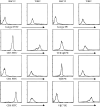Relationship between CD8-dependent antigen recognition, T cell functional avidity, and tumor cell recognition
- PMID: 18836717
- PMCID: PMC2773431
- DOI: 10.1007/s00262-008-0594-2
Relationship between CD8-dependent antigen recognition, T cell functional avidity, and tumor cell recognition
Abstract
Effective immunotherapy using T cell receptor (TCR) gene-modified T cells requires an understanding of the relationship between TCR affinity and functional avidity of T cells. In this study, we evaluate the relative affinity of two TCRs isolated from HLA-A2-restricted, gp100-reactive T cell clones with extremely high functional avidity. Furthermore, one of these T cell clones, was CD4- CD8- indicating that antigen recognition by this clone was CD8 independent. However, when these TCRs were expressed in CD8- Jurkat cells, the resulting Jurkat cells recognized gp100:209-217 peptide loaded T2 cells and had high functional avidity, but could not recognize HLA-A2+ melanoma cells expressing gp100. Tumor cell recognition by Jurkat cells expressing these TCRs could not be induced by exogenously loading the tumor cells with the native gp100:209-217 peptide. These results indicate that functional avidity of a T cell does not necessarily correlate with TCR affinity and CD8-independent antigen recognition by a T cell does not always mean its TCR will transfer CD8-independence to other effector cells. The implications of these findings are that T cells can modulate their functional avidity independent of the affinity of their TCRs.
Figures



Similar articles
-
Characterization of MHC class-I restricted TCRalphabeta+ CD4- CD8- double negative T cells recognizing the gp100 antigen from a melanoma patient after gp100 vaccination.Cancer Immunol Immunother. 2009 May;58(5):709-18. doi: 10.1007/s00262-008-0593-3. Epub 2008 Oct 3. Cancer Immunol Immunother. 2009. PMID: 18836718 Free PMC article.
-
Peptide fine specificity of anti-glycoprotein 100 CTL is preserved following transfer of engineered TCR alpha beta genes into primary human T lymphocytes.J Immunol. 2003 Feb 15;170(4):2186-94. doi: 10.4049/jimmunol.170.4.2186. J Immunol. 2003. PMID: 12574392
-
High efficiency TCR gene transfer into primary human lymphocytes affords avid recognition of melanoma tumor antigen glycoprotein 100 and does not alter the recognition of autologous melanoma antigens.J Immunol. 2003 Sep 15;171(6):3287-95. doi: 10.4049/jimmunol.171.6.3287. J Immunol. 2003. PMID: 12960359 Free PMC article.
-
Antitumor cytotoxic T-lymphocyte response in human lung carcinoma: identification of a tumor-associated antigen.Immunol Rev. 2002 Oct;188:114-21. doi: 10.1034/j.1600-065x.2002.18810.x. Immunol Rev. 2002. PMID: 12445285 Review.
-
Potential use of T cell receptor genes to modify hematopoietic stem cells for the gene therapy of cancer.Pathol Oncol Res. 1999;5(1):3-15. doi: 10.1053/paor.1999.0003. Pathol Oncol Res. 1999. PMID: 10079371 Review.
Cited by
-
The promise and potential pitfalls of chimeric antigen receptors.Curr Opin Immunol. 2009 Apr;21(2):215-23. doi: 10.1016/j.coi.2009.02.009. Epub 2009 Mar 25. Curr Opin Immunol. 2009. PMID: 19327974 Free PMC article. Review.
-
Understanding TCR affinity, antigen specificity, and cross-reactivity to improve TCR gene-modified T cells for cancer immunotherapy.Cancer Immunol Immunother. 2019 Nov;68(11):1881-1889. doi: 10.1007/s00262-019-02401-0. Epub 2019 Oct 8. Cancer Immunol Immunother. 2019. PMID: 31595324 Free PMC article. Review.
-
Transduction of human T cells with a novel T-cell receptor confers anti-HCV reactivity.PLoS Pathog. 2010 Jul 29;6(7):e1001018. doi: 10.1371/journal.ppat.1001018. PLoS Pathog. 2010. PMID: 20686664 Free PMC article.
-
Constant regulation for stable CD8 T-cell functional avidity and its possible implications for cancer immunotherapy.Eur J Immunol. 2021 Jun;51(6):1348-1360. doi: 10.1002/eji.202049016. Epub 2021 Mar 30. Eur J Immunol. 2021. PMID: 33704770 Free PMC article. Review.
-
Molecular properties of gp100-reactive T-cell receptors drive the cytokine profile and antitumor efficacy of transgenic host T cells.Pigment Cell Melanoma Res. 2019 Jan;32(1):68-78. doi: 10.1111/pcmr.12724. Epub 2018 Aug 13. Pigment Cell Melanoma Res. 2019. PMID: 30009548 Free PMC article.
References
-
- Finke JH, Zea AH, Stanley J, Longo DL, Mizoguchi H, Tubbs RR, Wiltrout RH, O’Shea JJ, Kudoh S, Klein E, Bukowski RM, Ochoa AC. Loss of T-cell receptor zeta chain and p56lck in T-cells infiltrating human renal cell carcinoma. Cancer Res. 1993;53(23):5613–5616. - PubMed
Publication types
MeSH terms
Substances
Grants and funding
LinkOut - more resources
Full Text Sources
Other Literature Sources
Medical
Research Materials

